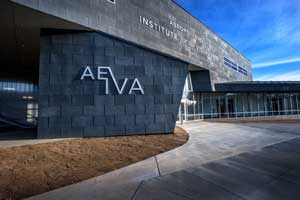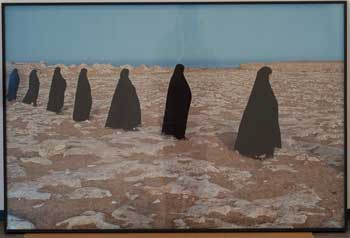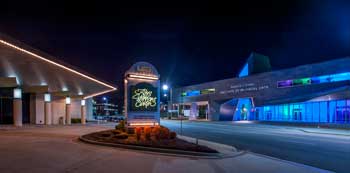The University of Alabama at Birmingham College of Arts and Sciences will open its new Abroms-Engel Institute for the Visual Arts to the public Thursday, Jan. 16.
 Adjacent to UAB’s Alys Stephens Performing Arts Center on 10th Avenue South, the AEIVA houses academic classrooms and laboratories for instruction, offices for students and faculty of the Department of Art and Art History, and a series of professional art galleries for exhibitions. Art history, time-based media and graphic design classes are located on the building’s second floor. The 26,000-square-foot building was named for lead donors Judy and Hal Abroms and Ruth and the late Marvin Engel. Additional major donors include Gail and Jeffrey Bayer, the Ronne and Donald Hess Foundation, and Carol and the late Jack Odess. The building was designed by renowned Los Angeles-based architect Randall Stout. Hoar Construction, based in Birmingham, oversaw the construction of the building.
Adjacent to UAB’s Alys Stephens Performing Arts Center on 10th Avenue South, the AEIVA houses academic classrooms and laboratories for instruction, offices for students and faculty of the Department of Art and Art History, and a series of professional art galleries for exhibitions. Art history, time-based media and graphic design classes are located on the building’s second floor. The 26,000-square-foot building was named for lead donors Judy and Hal Abroms and Ruth and the late Marvin Engel. Additional major donors include Gail and Jeffrey Bayer, the Ronne and Donald Hess Foundation, and Carol and the late Jack Odess. The building was designed by renowned Los Angeles-based architect Randall Stout. Hoar Construction, based in Birmingham, oversaw the construction of the building.
“Growing the arts and culture is a priority for UAB, and the new Abroms-Engel Institute for the Visual Arts represents a major stride in those efforts,” said UAB President Ray L. Watts, M.D. “The Institute will transform our Department of Art and Art History, offer new and innovative opportunities for education, share the outstanding work of our faculty and students with a much broader audience, and attract acclaimed artists from around the world to UAB. The AEIVA joins the Alys Stephens Performing Arts Center, the William Hansell and Susan Mabry Hulsey Center for Arts and Humanities and the National Alumni Society House in a burgeoning cultural arts corridor that is a tremendous asset for UAB, Birmingham and the state of Alabama.”
 "Women in a Line" from Material EvidenceThe AEIVA is more than just a building — it is a work of art in itself, says UAB College of Arts and Sciences Dean Robert E. Palazzo, Ph.D.
"Women in a Line" from Material EvidenceThe AEIVA is more than just a building — it is a work of art in itself, says UAB College of Arts and Sciences Dean Robert E. Palazzo, Ph.D.
“After much work, we are proud to open this new Institute for the Visual Arts to UAB and to the public, and we hope it will inspire and interest all who see it and experience what it has to offer,” Palazzo said. “We recognize the importance of the creation of art as a fundamental form of human expression. It is a foundation for a comprehensive education in the liberal arts and sciences. The AEIVA provides the College of Arts and Sciences, UAB, and the city of Birmingham with a new forum for the creation of original works of art, the exhibition of art, and the resulting intellectual exchange that is needed to achieve a comprehensive education.”
The AEIVA’s inaugural exhibition, “Material Evidence: Art in Search of Representation and Identity,” was curated by the Birmingham Museum of Art and features works in two galleries culled from the impressive private collections of some of Birmingham’s most dedicated art collectors and enthusiasts. The third gallery will feature selections from the UAB Permanent Art Collection. Both shows will be on exhibition Jan. 16 to March 6. The AEIVA, located at 1221 10th Ave. South, is open to the public 10 a.m.-6 p.m. Monday-Friday and 12-6 p.m. Saturday and is closed Sundays and holidays. Visit the AEIVA online at www.uab.edu/cas/aeiva or call 205-975-6436. A complete schedule of events presented by the UAB Department of Art and Art History at the AEIVA in 2014 is available.
 Gail C. Andrews, the R. Hugh Daniel director of the Birmingham Museum of Art, says the museum is delighted to curate the inaugural exhibition for the AEIVA.
Gail C. Andrews, the R. Hugh Daniel director of the Birmingham Museum of Art, says the museum is delighted to curate the inaugural exhibition for the AEIVA.
“The Institute is physically beautiful and brings a freshness and excitement to our community — and not just the art community, the entire city,” Andrews said. “We believe this space can be an incubator for ideas and dialogue, attracting people across campus and across the city. Birmingham is incredibly fortunate to have a large and impressive group of art collectors, and ‘Material Evidence’ highlights the excellence and diversity of many of these private collections. We are incredibly grateful to them for their enthusiasm for this project and their willingness to share these objects with the public.”
Lenders to the exhibition include Margaret and Bruce Alexander, Catherine and Bill Cabaniss, Lydia Cheney and Jim Sokol, Charlsie and Ralph Cook, Carnetta and Norm Davis, Rebecca and Jack Drake, Ellen and Fred Elsas, Beverly and Stanley Erdreich, John Hagefstration, Barbara and Basil Hirschowitz, Dick Jemison, John Morton, Karen and Joel Piassick, Nancy and John Poynor, Leslie and Elton Stephens Jr., Michael Straus, and Carolyn Wade.
The AEIVA will house works from UAB’s permanent collection that include Polaroids and prints by Andy Warhol; a Pablo Picasso lithograph; six large James Rosenquist lithographs; eight Donald Judd etchings; large-format Polaroids, particularly those by William Christenberry; Christo’s “Mein Kölner Dom, Wrapped”; an Anthony Caro paper sculpture; a mural by Dzine; a painting by James Marshall, aka Dalek; and much more.
The building features state-of-the-art security and environmental control systems for humidity, temperature and UV exposure, as well as a loading/unloading bay within the building so works are always climate-controlled.
Based on a palette of red brick, glass and patinaed zinc, the AEIVA will have an outdoor sculpture garden, a covered art plaza and exterior spaces for gathering. A two-story atrium allows natural light to flood the glass-enclosed, ground-floor lobby. Both the lobby and the atrium provide views between second-floor academic spaces and ground-floor public access as well as into and out of the facility. The art plaza, an extension of the main lobby, will support events from catered dinners to performances. The design also includes an education bar, light monitor and elevator cube on the north side of the main public entrance, and a canopy over the gallery concourse.